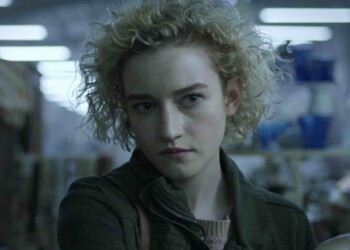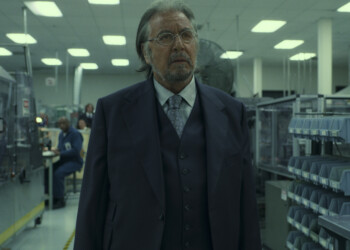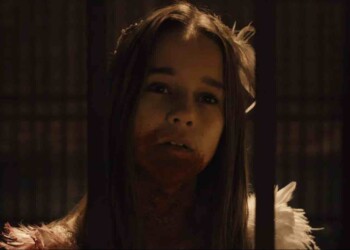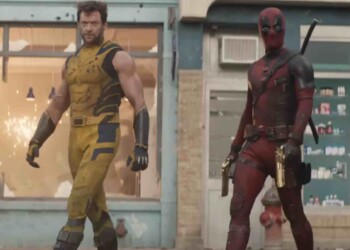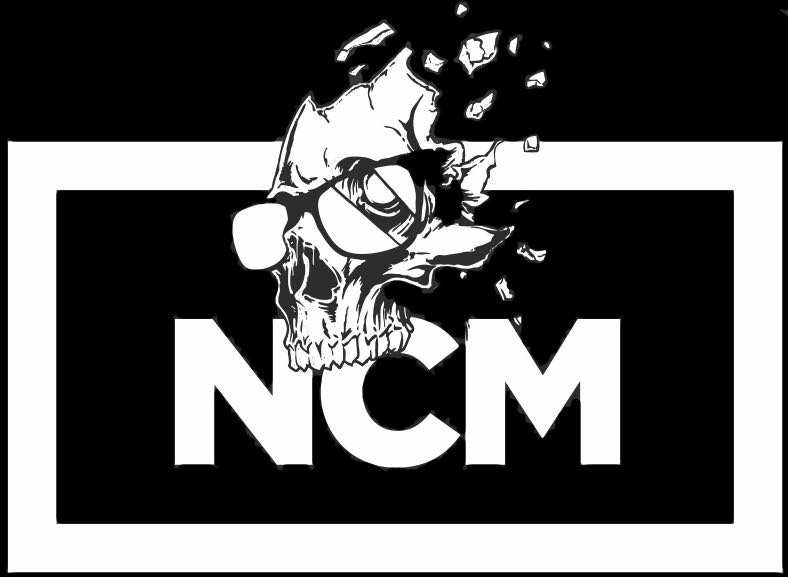True Detective is masquerading as a cop drama but in reality this is the horror show fans of the genre have been waiting on for decades…
By Damon Martin — Editor/Lead Writer
Before the series True Detective ever debuted on HBO, I had already decided I was going to invest in the series for at least a few episodes if for no other reason than the stellar cast being put together for the eight episode anthology series.
Woody Harrelson and Michelle Monaghan probably would have been enough for me to watch an hour or two without blinking an eye, but the addition of Matthew McConaughey virtually sold me on the series before it started. Lately, McConaughey’s name has appeared in every story being written when it comes to awards, mostly for his role in True Detective and for his turn in the Oscar nominated film Dallas Buyers Club, with a note attached to each piece of work saying how this is a career restart for a once promising actor who faded into mediocrity over the last few years.
Personally, I disagreed with those statements because there were several movies over the last eight or nine years featuring McConaughey that I enjoyed, but regardless he’s having a hell of a year and it will likely be capped off with a lot of gold statues, acclaim, and even bigger and better roles being thrown at him like beads during Mardi Gras.
Back to the start — True Detective was not a defined series when I first saw the advertisements for it on HBO or even when I caught a glimpse of the debut trailer. Admittedly, I’m not a huge fan of cop dramas outside of a series like ‘The Shield‘ and crime stories such as Law & Order or CSI are fine programs I’m sure, but the tedious investigation procedurals do nothing to draw in my interest and I’ve always tuned out within about 15 minutes of any episode.
While television, in my humble opinion, has become far superior to film in terms of overall storytelling and compelling character development, actors and actresses best known for being movie stars rarely lower their asking price to do any kind of TV work especially given the length of contracts (standard TV deals come with a seven year agreement) and the brutal nature of shooting schedules. Typically, television actors are much more likely to film movies in their spare time and rarely does it ever go the other way around.
So it was positively delightful to see two movie stars still actively filming movie roles take a shot at this anthology series lasting eight hours while unraveling what would become one of the most intriguing shows of the last 10 years.
But what I noticed just 60 minutes into this series was that it wasn’t anything like the cop shows I avoided for so many years. Sure there was plenty of male cop swagger and Harrelson’s character Marty Hart came across as the typical cocksure ex-jock who strapped on a badge and a gun for the sole purpose of nailing some crazy pussy on his way to the policeman’s league softball game on Tuesday nights, but still even his character had a dozen different layers as a family man, a cheating husband, an absentee father and misguided detective trying to handle a partner who quotes Nietzsche and believes human existence as a whole is a mistake.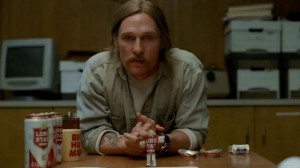
The other major thing I noticed as the first episode came to a close as Detective Rust Cohle wandered into the outdoor shed of a kidnap victim’s house where he found a creepy twig statue similar to the ones he and Hart had discovered at the cult site alongside victim Dora Lange is that this series while dressed up as a cop show with two very distinct personalities leading a murder investigation is really a cleverly disguised horror film brought to life on television.
All of the classic elements of a horror film are there, but like so many excellent thrillers from the past, this show is best served if it isn’t attached to that particular word and instead looked at as a drama with dark overtones. At the heart of it all, True Detective (at least this first installment) is much more akin to films like ‘Seven‘ or ‘Silence of the Lambs‘ than any cop shows or movies that have aired previously.
Unlike a series such as The Walking Dead, which is extremely well done in a supernatural realm, True Detective straddles the line between real life and the unbelievable. Cult murders happen all over the world, but the intricacies that creator Nic Pizzolatto has crafted in this particular corner of the universe has been unsettling and intriguing all at the same time. The backdrop of Louisiana’s cloudy skies, dimly backlit swamps and deep-seeded religious roots only goes to strengthen the mythology being unveiled one episode at a time.
One of the strongest ties Pizzolatto has managed to create with this series is the relation to a real work of art, forcing viewers to delve into their own psyches to try and find answers before the show can reveal them each Sunday night. A big part of the mythos surrounding True Detective has centered around the 1895 book ‘The King in Yellow’ by Robert Chambers. The series of short stories is based around a play of the same name that drives readers into madness by just strolling through a few words in the script.
This concept has been created, rehashed and redone dozens of times in books, movies, and TV shows, but what True Detective did differently was to use ‘The King in Yellow’ as a bible of sorts for the cult that was created for this show. Does ‘The King in Yellow’ really drive anyone into insanity? Of course not, but does that mean there isn’t somebody out there who would read the words in the book, find some prophetic meaning and believe that it’s speaking directly to them and the actions that must be taken as a result? Thus the Yellow King that we keep hearing about in the series is created. If this book really has driven anyone mad, it’s the viewers and critics who discovered ‘The King in Yellow’ for the first time because of True Detective and began theorizing plots for the series while dissecting every word in the book trying to find answers and the hidden mysteries enveloped in the book. The text in the book is over 100 years old at this point, but Pizzolatto managed to resurrect the idea behind it all while crafting and weaving it into his own story that we all now obsess over week after week leading up to the new episode.
The Yellow King himself, assuming he truly exists, is the supernatural element similar to all the great horror movies of the past century. In this story he’s a human being just like everyone else so don’t expect the bogeyman to pop out at any point in the series finale in two weeks, but the build up to his revelation has been taut suspense all season long. Real life can be even scarier than fantasy because these people actually exist. For instance in ‘Silence of the Lambs’ at one point while the police are guarding Hannibal Lecter and Clarice Starling comes to visit him, a young officer asks her if he’s some kind of vampire. It’s no different in True Detective as our curiosity peaks each week trying to figure out what or who The Yellow King is exactly. He’s a man with scars that we first heard about during the religious tent revival in 1995 and now he’s back again after the catatonic victim that Rust and Marty saved woke up just long enough to unload that crucial piece of information before breaking down in shrieks of terror.
I know he’s not Michael Myers or Freddy Krueger, but there’s a deep dark secret we still haven’t learned about this character and it will be revealed in the next few weeks, while likely leaving our collective jaws on the floor.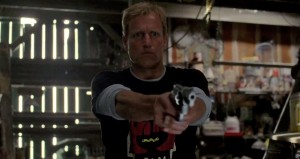
Another similarity that True Detective shares with the horror genre is the time spanning story telling that’s being done this season. Just like in films such as ‘Halloween‘ or ‘Nightmare on Elm Street‘ where the killer’s back story twists, turns and then unfolds over the course of many years, so does the murder investigation surrounding Dora Lange, the Yellow King and our modern day former cops who are still haunted by the case that made them famous. Rust Cohle’s obsession with the case has stretched out almost two decades at this point from the bullet that blew through Reggie LeDoux’s head, subsequently severing any chances he had of telling his real story to the cops, to the multiple drug store murderer who uttered the words ‘Yellow King’ to him seven years later. Maybe ‘The King in Yellow’ really did drive him mad because before he could tell Cohle another word, he slit his wrists and died in a prison cell — all after receiving a mysterious call that was traced back to a payphone with no way of telling who dialed up his suicide.
Rust’s obsession led to him leaving the police force, going into solitude to continue the investigation on his own, and now it’s brought him back full circle (maybe a flat one at that) to a new murder where his undying efforts to find out who was really responsible for everything also managed to make him the prime suspect for the new detectives working the case. It’s classic horror story telling at its best.
Now one big difference that True Detective doesn’t share with many films in the horror genre is the strong, central lead for a female character on the show. Dozens of journalists have noticed, of course, and torn into the series for portraying the women as secondary characters mostly around for some T&A or playing the victims as fodder for the decades long murder spree this supposed cult leader has been on. Horror films have traditionally embraced the female heroine from Jamie Lee Curtis to Neve Campbell as the meek, tender women who find strength to fight back and ultimately save the day when their male counterparts use more brawn than brains to battle the enemy. While women haven’t been the leads in True Detective, I don’t think they have been only victims either.
Take for instance Marty’s first ‘girlfriend’ Lisa, who he is sleeping with on the side behind his wife’s back. His territorial nature is almost predatory when he finds out she’s sleeping with another guy, but her revenge is much more damaging in the long run because she’s smart enough to know she won’t beat muscle with muscle so instead she goes straight for the heart. She tells Marty’s wife Maggie that she’s been sleeping with him for months and effectively implodes his entire life in one felt swoop. Meanwhile, Maggie has been portrayed largely as a speed bump in Marty’s reckless life for much of the season, but she’s also a deeply conflicted character who finally snaps after her husband’s repeated extramarital affairs and uses his partner Rust as the ultimate act of payback. She takes all of the turmoil, angst and betrayal, balls it up and flings it at Marty like a grenade wrapped in barbed wire.
Then there’s Rust and Marty themselves — the quintessential horror movie duo. Rust is a pessimist at heart driven by nihilistic tendencies and a world of random order where bad things happen to good people all the time. He doesn’t believe in forgiveness only consequence, and his mind is so sharp and razor like that the only way he can slow down for any significant amount of time is to drown out the white noise with can after can of Lone Star beer and a flask of whiskey. Marty on the other hand is the All-American alpha male driven mostly by whichever way his dick points him on a given day while missing all the signs around him that life at home is far from ideal. He’s passing his wife on a two-lane highway towards a divorce, while one kid grows up drawing pictures of murder victims and posing her dolls in sexual positions whereas the other one is a cheerleader with dancing visions of honor rolls in her head.
Rust is the investigator’s investigator, spending hour after hour sifting through case files just hoping to find the right one to connect the dots on this murder investigation. Meanwhile, Marty is his backup racing with the car to pull him out of the projects after a heist gone wrong or serving as the firepower during an arrest to get rid of the bad guy when he discovers abused children in captivity. Rust thinks, Marty reacts — both character tenants of the classic horror movie partnership.
The creepy, Southern fried backdrop full of religious icons and grimy crime scenes all put together are a canvas perfectly made for horror and it’s no mistake that the imagery and scenery used throughout the show invoke a certain uneasiness. Only in buildings like the police station or where zealot Billy Lee Tuttle reign are bright lights shone verses the dingy, broken and dilapidated areas where our victims live. Each new place we visit leaves us unsettled, and each new stone overturned reveals the dirty underside of a gloomy world full of murder, prostitution, abuse and corruption. Great horror scares you with elements like these and not the jump out from behind a wall type frights we so often associate with the genre.
As True Detective spirals towards the final two episodes, there are plenty of questions that need to be answered and more characters that have to be revealed. Now in the present day, Marty and Rust reunite to finish the job they started 17 years earlier when they thought the Dora Lange case was dead and buried like a bullet deep inside the grey matter of Reggie LeDoux. Instead their case is coming back around in the here and now, and how it touches them could very easily drive one or both of them into madness and that is horror at its very best.
And as it turns out maybe ‘The King in Yellow’ will succeed in the end.

